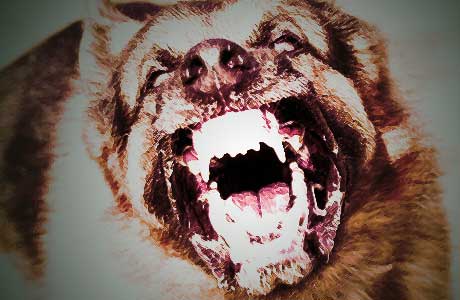BARRY McCANN looks at England’s history of terrifying Black Dogs, from Black Shuck to the Hounds of the Baskerville…

Mysterious four legged black beasts may be the stuff of folklore, but even in these modern times they still make the papers. How many times have we seen headlines concerning the Beast of Bodmin Moor or sinister black pumas that appear and disappear seemingly out and into thin air? In centuries past there a monstrous black dog that became a cause celeb around the counties of Norfolk and Suffolk. One who then inspired popular fiction’s most famous hound from hell – Black Shuck.
Shuck may originate in the Old English word “scucca” meaning “witch”, or alternatively from the dialect shucky meaning “shaggy” or “hairy”. Either way, Black Shuck lends itself to both being a hairy harbinger of doom.
Its legendary appearances in 1577 at both Norfolk and Suffolk particularly cemented sinister black hounds as part of popular iconography. On the morning of the 4th August the parishioners of Bungay, Norfolk, were worshipping in their local church when a violent thunderstorm broke out, followed by a large black dog running down the aisle at great speed. It reputedly wrung the necks of two parishioners kneeling at prayer, while another was struck on the back with such force as to leave a burn injury. After the beast left, it was discovered that all the wheels and wires in the church clock had been smashed.
That same morning, the storm crossed counties to reach the church at Blythburgh, Suffolk, where the dog appeared on a main beam in the roof of the church before leaping down amongst the congregation, killing two men and a boy, before leaving the building with a huge thundering sound. The apparent claw marks of the beast inside the north door of the church can still be seen to this day.
But where these calamities the work of a supernatural hound from hell, or simply the results of an unusually fierce thunderstorm? The storm itself would be seen by superstitious folk as the work of the devil, and the dog a mythical metaphor of it?
As recent as 1972, a coastguard report from Gorleston, Norfolk, confirmed a possible sighting of Black Shuck. Graham Grant described how while on night duty at the rescue headquarters on April 19th at 0445hrs, “I saw a large black hound type dog on the beach, about a quarter of a mile north of the lookout. What made me look was that the dog was running then stopping, as if looking for someone. I watched it for one or two minutes and then it vanished before my eyes. I kept on looking for a time but it did not reappear.”
Mr. Grant had recently transferred from another part of the country the officer and claimed never heard the story of Black Shuck before. It was only after this sighting that a colleague, Harold Cox of Cromer, told him of the legend.
And it is at Cromer that Black Shuck made its metamorphosis into its more famous incarnation, The Hound of the Baskervilles. In 1901, Conan Doyle was staying in the Royal links Hotel in Cromer with his friend and golfing partner, Bertram Fletcher Robinson, a journalist with the newly founded Daily Express. Prior to this trip, Fletcher Robinson had visited Max Pemberton in Hampstead who later confirmed that he related the legend of Black Shuck to the journalist, having been told about it himself by a Norfolk marshman called Jimmy Farman.
The speculation is that, given they were staying in Cromer, Fletcher Robinson told Conan Doyle of this local legend and that planted the seed of a new Sherlock Holmes mystery. It is reported that the author did write to his mother from Cromer mentioning new book on which he was about to start work. Given he also had a close friend in Devon, which has its own folklore of devil dogs, may account for the decision to set it in Dartmoor with its deadly bogs and quicksands.
But apart from the documented sighting in 1972, has anything more been seen of Black Shuck? Not unless he has transformed into a feline, as they seem to be the black spectres roaming Anglia and other rural areas these days. Question is where to they come from, and where do they go?
(With thanks to Mandy Horton)

